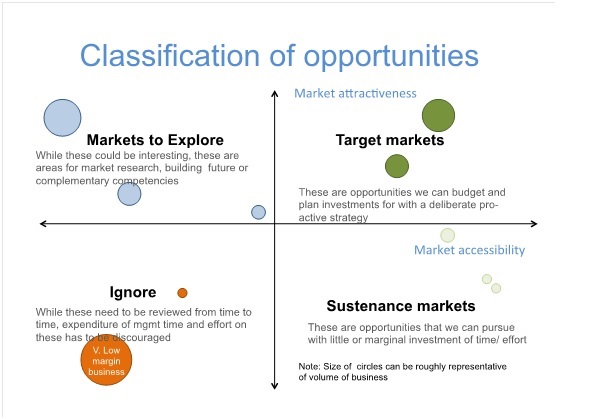In either choosing a market for entry or expansion, we have found use of a simple 2X2 as below, invaluable in making decisions. The need for choice is always driven by scarcity of resources for required market development marketing spends.

The framework itself looks deceptively simple. Use of this framework requires us to define the terms ‘market attractiveness’ and ‘market access’.
In theory ‘market attractiveness’ has to do with the following-
- A large growing market indicating opportunities
- In conjunction with few entrenched competitors
- Good price realizations and margins
- Leading indicators of robust demand
In markets for new product/ service offerings, market sizing could be a challenge as can be estimating price that the market will bear. Here, use of the market for ‘close substitutes’ and benchmarking pricing to these is a solution. We have also learnt that even if the market is not fully developed, analysing the factors that could drive demand (like that for ready-to-cook foods driven by increasing share of double-income households) can point to a way to estimate possible growth rates.
‘Market access’ usually poses more challenges. Access to a market can be blocked either due to regulatory or cultural barriers, in which case, participation is impossible. However, leaving these aside other factors that we use as measures for access can include the following-
- Size of investment required either in product development, certification, or just capacity for the targeted markets.
- Geography (issues such as cost of exploration/ development and travel/ logistics would be covered here).
- Readiness of channels or key customers (decision-makers). In businesses where key account acquisition is time –consuming, sales gestation cycles are large, make it harder to access and penetrate markets.
- Need for high levels of pre-qualification or prior experience that can act as significant barriers to entry.
- Need for brand development and trademarking that can make the market hard to access.
When we have close competitors among markets for priorities, we look harder at the criteria to see if we can rank them using objective measures.
Despite some difficulty in arriving at specific judgements in respect of some parameters, in guiding clients through their choices and prioritizing markets for them, we have found this useful. Over time we have learnt to use this with greater skill to help clients resolve priorities.
